Just In
- 23 min ago

- 3 hrs ago

- 5 hrs ago

- 7 hrs ago

Don't Miss
- Education
 ICAI CA final, intermediate admit cards 2024 is OUT; Know steps to download
ICAI CA final, intermediate admit cards 2024 is OUT; Know steps to download - Sports
 Why is Dhanashree Verma not attending IPL 2024 matches of husband Yuzvendra Chahal?
Why is Dhanashree Verma not attending IPL 2024 matches of husband Yuzvendra Chahal? - Finance
 5 Bonus Issues, Rs 8/Share Dividend: Buy Multibagger Energy PSU, Dividend On April 30; TP Rs 195
5 Bonus Issues, Rs 8/Share Dividend: Buy Multibagger Energy PSU, Dividend On April 30; TP Rs 195 - Automobiles
 Kerala Spearheads Revival of Iconic Double-Decker Trains in India
Kerala Spearheads Revival of Iconic Double-Decker Trains in India - News
 23-Year-Old Bengaluru YouTuber Arrested For Faking 24-Hour Airport Stay
23-Year-Old Bengaluru YouTuber Arrested For Faking 24-Hour Airport Stay - Movies
 Hairstyles For This Summer: Alia's Braid To Ananya's Sleek Look, Celeb Approved Chic Styles You Must Try
Hairstyles For This Summer: Alia's Braid To Ananya's Sleek Look, Celeb Approved Chic Styles You Must Try - Technology
 Redmi Pad Pro 5G Likely to Launch Soon in India; Spotted on Google Play Console Database
Redmi Pad Pro 5G Likely to Launch Soon in India; Spotted on Google Play Console Database - Travel
 From Coconut Breaking on Head to Men Dressing as Women: 12 Unique Indian Rituals Explored
From Coconut Breaking on Head to Men Dressing as Women: 12 Unique Indian Rituals Explored
9 Rituals Associated With Durga Puja
Here are the 9 Rituals Associated With Durga Puja.
Most people know about Durga Puja. It is the main festival of West Bengal and is largely celebrated across the nation, where Goddess Durga is offered prayers. The Puja starts with the Shashti Tithi of Ashvin month falling during the Shukla Paksha of Ashvin month and continues for five days until Vijaya Dashami (Bijoya Dasami in West Bengal). There is a sign for every single ritual that is practised during Durga Puja. In order to know why we celebrate Duja Puja in a particular way, one needs to understand the mythological story behind this worship. Goddess Durga descends from her heavenly abode in Kailash to visit her devotees on earth every year. This year Durga puja will be celebrated from 26 September 2022 to 05 October 2022.
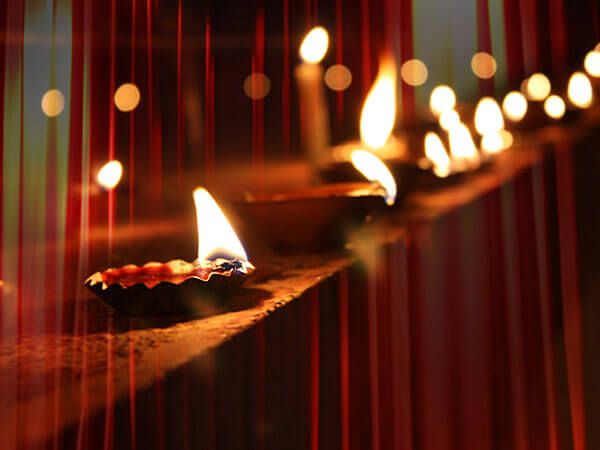
The Goddess comes with her children Devi Lakshmi, Devi Saraswati, Lord Ganesha and Lord Kartik. The Durga Puja rituals involve all these gods and goddesses. The devi paksha or the rituals for the puja begin from Mahalaya, which is 10 days before the puja. Mahalaya is the time period which falls between the Shradh and the Navratri of Ashvin month.
There is an elaborate Sandhi puja that is conducted on the evening of Maha Ashtami. This puja is done at the juncture of Ashtami and Navami. Another fun-filled ritual for Durga Puja happens on the day of Dashami or Dusshera called the Sindoor Khela. It is a ritual where married women adorn the Devi with vermilion and then also smear it on each other.
Durga Puja 2022: Puja Rituals
All the important 9 rituals associated with Durga Puja are listed below. Take a look.

1. Tarpan: Mahalaya
On the amavasya of Mahalaya, the Devi paksha starts. This is the day on which Goddess Durga begins her journey from Kailash. On this day, people give water in the name of their ancestors who are dead and gone. This act of remembrance is a sacred beginning of the Durga Puja festivities.

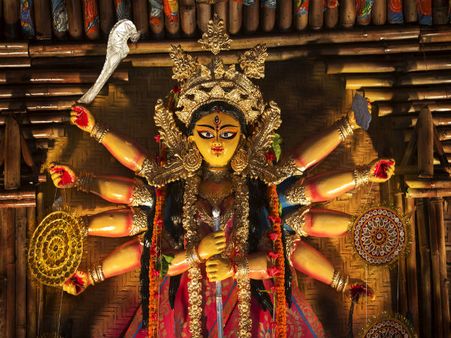
2. Kalaparambho: Mahashashti
This is the day on which the goddess reached the mortal world and to signify this, her face is uncovered on this day. The Kalaparambho puja marks the beginning of the puja and then there are the rituals of bodhan and adhibas.
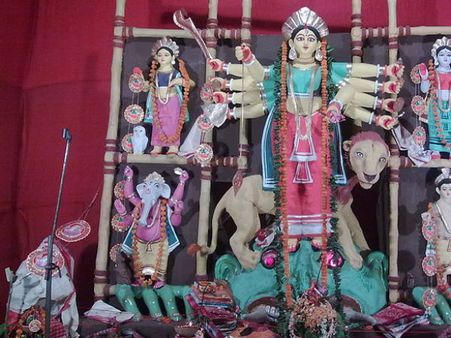
3. Bringing The Kola Bou: Mahasaptami
Kola Bou is a form created with plantain that is considered to be Lord Ganesha's bride. She is given a bath before the break of dawn and placed next to Ganesha on Maha Saptami.
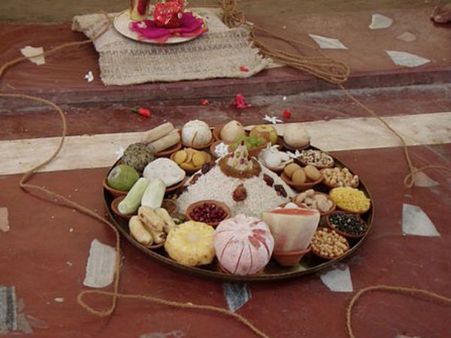
4. The Nine Plants Puja: Mahasaptami
There is another ritual of worshipping nine types of plants on Maha Saptami that are symbolic of the nine forms of the goddess herself. It is performed on the Saptami Tithi.
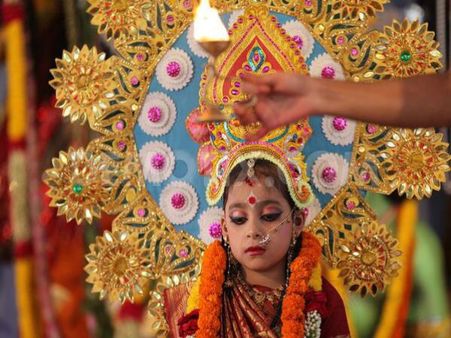
5. Kumari Puja: Maha Ashtami
During the day of Maha Ashtami, girls who have not reached their puberty yet are worshipped as the sacred forms of the Goddess herself. In some pandals, girls between 7 to 9 years are dressed up as the goddess and worshipped. This is done on the eighth day of Navratri.

6. Sandhi Puja: Mahanavami
The Sandhi puja that is done at the juncture of Maha Ashtami and Maha Navami is the main ritual of Durga Puja. The last 24 minutes of Ashtami and first 24 minutes of Navami are regarded as the Sandhikhan. This is believed to be the exact time at which Devi Durga slayed the notorious pair of demons Chando and Munda.

7. Sindoor Khela: Mahadashmi
On the last day of the puja, the devotees bid a tearful adieu to the Goddess. All the married women apply sindoor or vermilion in the parting of Maa Durga's hair and feed her sweets. This is called 'thakur boron'. After this, the women play with vermilion among themselves, this is called 'sindoor khela'.

8. Vijaya Dashmi: Mahadashmi
After the idols of the Goddess and her family have been immersed in water so that they can begin their journey back to Kailash, Vijaya Dashmi begins. You are supposed to greet your equals, seek the blessings of your elders and bless those who are younger to you.
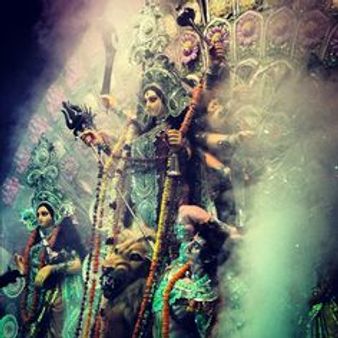
9. Visarjan
Finally, Goddess Durga has to go back to her heavenly abode again. The idol in immersed in water but not before the devotees have danced and frolicked around the Goddess and taken a promise to come back next year.
-
 astrologyDussehra 2023: These 5 Zodiac Signs Will Be Lucky Enough To Get Money, Prosperity, Blessings On Vijayadashami
astrologyDussehra 2023: These 5 Zodiac Signs Will Be Lucky Enough To Get Money, Prosperity, Blessings On Vijayadashami -
 yoga spiritualityDurga Puja 2023: Sindoor Khela Wishes, Greetings, Quotes, Images, FB And WhatsApp Status
yoga spiritualityDurga Puja 2023: Sindoor Khela Wishes, Greetings, Quotes, Images, FB And WhatsApp Status -
 yoga spiritualityNavratri 2023 Day 9: Budget-Friendly Gift Items For Young Girls On Kumari Puja
yoga spiritualityNavratri 2023 Day 9: Budget-Friendly Gift Items For Young Girls On Kumari Puja -
 yoga spiritualityNavratri 2023 Day 9: Sarvartha Siddhi Yoga Will Form On This Day, Know How It Is Related To Success
yoga spiritualityNavratri 2023 Day 9: Sarvartha Siddhi Yoga Will Form On This Day, Know How It Is Related To Success -
 yoga spiritualityNavratri 2023 Day 9: Maa Siddhidatri Puja Vidhi, Vrat Katha, Mantra, Bhog And Aarti, All You Need To Know
yoga spiritualityNavratri 2023 Day 9: Maa Siddhidatri Puja Vidhi, Vrat Katha, Mantra, Bhog And Aarti, All You Need To Know -
 astrologyNavratri 2023 Day 8: Maa Gauri Puja Vidhi, Vrat Katha, Mantra, Bhog And Aarti, All You Need To Know
astrologyNavratri 2023 Day 8: Maa Gauri Puja Vidhi, Vrat Katha, Mantra, Bhog And Aarti, All You Need To Know -
 beautyDurga Puja Makeup Tips For Skin With Large Pores
beautyDurga Puja Makeup Tips For Skin With Large Pores -
 yoga spiritualityNavratri 2023: Maa Kalratri Puja Will Remove Your Fear Of Untimely Death, Follow This Worship Method
yoga spiritualityNavratri 2023: Maa Kalratri Puja Will Remove Your Fear Of Untimely Death, Follow This Worship Method -
 fashionNavratri 2023: Grey Ethnic Outfit Ideas For Day 7, Find The Style Inspiration From Bollywood!
fashionNavratri 2023: Grey Ethnic Outfit Ideas For Day 7, Find The Style Inspiration From Bollywood! -
 yoga spiritualityNavratri 2023: Kumari Puja Items That You Must Give To Young Girls During Kanjak Puja
yoga spiritualityNavratri 2023: Kumari Puja Items That You Must Give To Young Girls During Kanjak Puja -
 yoga spiritualityNavratri 2023 Day 7: Maa Kalratri Puja Vidhi, Vrat Katha, Mantra, Bhog And Aarti, All You Need To Know
yoga spiritualityNavratri 2023 Day 7: Maa Kalratri Puja Vidhi, Vrat Katha, Mantra, Bhog And Aarti, All You Need To Know -
 yoga spiritualityNavratri 2023: Significance Of Lemon Mala (Garland) In Kali Puja
yoga spiritualityNavratri 2023: Significance Of Lemon Mala (Garland) In Kali Puja


 Click it and Unblock the Notifications
Click it and Unblock the Notifications




